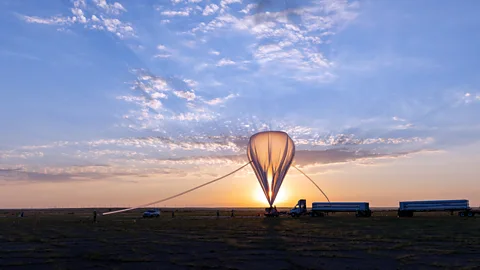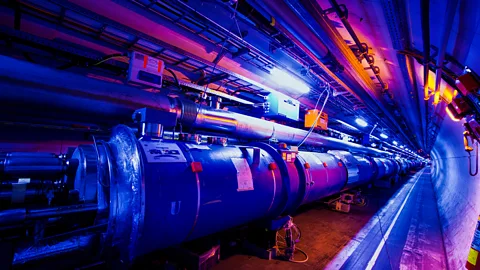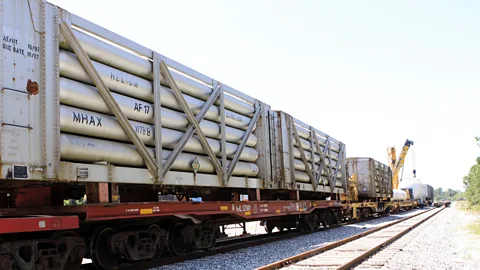The world keeps running out of helium. There is now a race to prepare for the next shortage
 Nasa/ Sophia Roberts
Nasa/ Sophia RobertsOur lives are surprisingly dependent upon this extremely light and unreactive gas, yet supplies of it are remarkably fragile.
Nancy Washton remembers the sinking feeling she got when she heard her helium delivery wouldn't be arriving. In early 2022, she and her team of chemists at the Pacific Northwest National Laboratory in the United States were abruptly told by their supplier that they wouldn't get their usual shipment of the gas, which they use in a range of different experiments.
Shortages meant there wasn't enough to go around, and the laboratory would simply have to make do with less. In the first weeks of that year, the laboratory's supply dropped well below the 2,500 litres (660 gallons) it normally received. By April, just a couple of months later, it was getting less than half the helium it needed.
With a small fleet of instruments that require regular top-ups of liquid helium, the lab had no choice but to sacrifice the greediest of these in order to continue running the most important. Washton's own instrument of choice was a nuclear magnetic resonance spectrometer – a huge, hulking tower, capable of peering into the molecular structure of atoms. Such measurements can contribute to the development of new batteries and energy storage systems, for example.
The spectrometer was the only one of its kind in North America, and less than 12 months after its installation it was providing results that were potentially game-changing. When turned on samples of magnesium oxide, for example, it showed the minerals are capable of pulling carbon out of the atmosphere. Such "carbon mineralisation" has long been explored as a way of combatting greenhouse gas emissions, but the results showed how useful these minerals could be.
"There had been no definitive evidence of carbonate formations on these particular types of magnesium oxides [before]," says Washton. "I just could not believe the data. The fact that we had managed to get this data, and the beauty of the story it told, was just amazing," Washton says.
But then all of that work abruptly had to stop.
The rate at which the spectrometer consumed helium made it a problem. In a process Washton later described as "traumatising", the instrument was de-energised and mothballed, its experiments suspended. It would sit inert and useless for several months until more helium could be secured. Today, the device is back up and running – the lab has the helium it needs. For the time being.
What is helium used for?
Helium is an inert gas, which means that it does not react readily with other substances. It has the lowest boiling point of any element at -269C (-452F) and a low density.
The space industry uses helium to keep satellite instruments cool and to clean out rocket engines. It is also used to pressurise the fuel tanks of space rockets.
Helium also cools equipment within the Large Hadron Collider (LHC) as well as the superconducting magnets in medical MRI scanners.
Helium is often used to fill party balloons, weather balloons and airships due to its low density.
Deep-sea divers rely on helium to control the proportions of oxygen and nitrogen they get from their breathing apparatus, since this helps to avoid decompression sickness.
The episode highlights how vulnerable helium supplies are and why there is now a desperate scramble around the world to find ways of conserving and recycling this crucial gas.
The shortages in 2022 didn't just affect researchers. You might not realise it, but many of the products and processes you encounter each day depend on helium.
Hospitals, for example, are the world's largest consumers of helium, accounting for around 32% of the global market. The gas is used to cool magnets in vital diagnostic tools such as magnetic resonance imaging (MRI) scanners. Helium is also used in the manufacturing of the semiconductors (computer chips), which are at the heart of electronic devices. It's also used in welding and even pressurises the fuel tanks of rockets that put satellites into orbit. Plus, helium is part of the gas mixture that inflates car safety airbags.
Helium is odourless, extremely light and, unlike another very light element once used in airships, hydrogen, it will never burst into flames. When cooled, it only condenses into a liquid at the stunningly low temperature of roughly 4.2 Kelvin, or -269C/-452F. Plus, under normal atmospheric conditions, helium will not freeze even at temperatures as low as absolute zero, or 0 Kelvin (-273C/-460F). This makes it incredibly useful.
"Helium is a magical element," says Sophia Hayes, professor of chemistry at Washington University in St. Louis. "There is nothing else like it in the Universe."
Liquid helium takes on strange properties when it is chilled almost to absolute zero, turning into a superfluid that flows without friction. Stir a cup of superfluid helium and the liquid inside would theoretically keep spinning forever. Superfluid helium has become vital for large-scale superconductors, such as those used by the Large Hadron Collider experiment at Cern on the border between Switzerland and France.
 Alamy
AlamyBut since 2006, helium has repeatedly been in short supply. The most recent extended shortage started in January 2022 before easing the following year. But helium supplies have remained precarious, with producers struggling to keep up with demand.
That demand is only expected to rise further – with some analysts predicting that it will double by 2035 due to helium's key roles in semiconductor and electric vehicle battery manufacturing, as well as in aerospace applications.
There are only two sources of helium: the highly-energetic nuclear fusion reactions inside stars, including our Sun, and the slow decay radioactive elements in Earth's crust. Since we can't artificially manufacture helium with today's technology, that means it is essentially a finite resource. Instead, helium is typically mined alongside natural gas by drilling deep wells into the ground, but only a handful of companies across the world currently do this.
Helium is also a remarkably uncooperative element. The extraction and burning of fossil fuels have caused increasing amounts of helium to build up in the Earth's atmosphere in recent decades, depleting the resource otherwise locked inside our planet.
But helium is so light that it is also slowly leaking out of the Earth's atmosphere and heading off into space. In its superfluid state, it has a habit of finding its way out of even the tiniest cracks and holes. It can even flow up walls in this superfluid state. That makes it difficult to handle and store – it can be easily lost after use.
All of this makes the helium supply chain fragile – resulting in four worldwide helium shortages in the last twenty years alone.
The most recent severe shortage in 2022 that scuppered some of Washton's research occurred after a series of fires at a major Russian gas processing plant in the Amur region of Siberia. The war in Ukraine compounded the problem by further choking supplies at the same time a helium plant in Qatar went offline for planned maintenance. Meanwhile, the crude helium enrichment unit at the US National Helium Reserve was shut down during the summer of 2021 and again for four months at the end of January 2022. The US shutdown removed around 10% of the global production capacity of helium from the supply chain. Taken together, these incidents led to a sudden shortage and highlighted just how vulnerable the world's helium supply could be. By 2023, the industrial sale price of helium had nearly doubled from what it was five years before, reaching an all-time high.
 Nasa/ Jim Grossmann
Nasa/ Jim GrossmannAlthough helium production has since increased, the world yet again faces potential disruption, leaving market prices volatile. In September 2024, the EU began enforcing new sanctions on Russia over its war in Ukraine, including banning imports of helium. While Russia accounts for only 1% of the EU's helium imports, the move marked a further tightening of supplies. On top of that, the sale of the world's largest helium reserve – the US Federal Helium Reserve – has triggered further uncertainty.
For several decades, the US has supplied around one-tenth of the world's helium from an underground federal stockpile established a century ago near Amarillo, Texas. But in June 2024, the Bureau of Land Management, which ran the US helium reserve, sold the last gasp of federal helium to the German gas supplier Messer. Ahead of the handover, the US National Academies of Science, Engineering and Medicine released a report warning that the sale of the strategic reserve to a commercial company could heighten uncertainty in the helium market.
Trade bodies including The Compressed Gas Association and the Advanced Medical Technology Association – AdvaMed – urged the US government to delay the sale on the grounds that it risked a "supply chain crisis". And healthcare contractor Premier Inc, which sources helium on behalf of thousands of hospitals, suggested the sale could have a detrimental impact on patient care.
Although these fears are yet to be realised, there are signs that not all is going smoothly.
Within months of the sale, Messer was forced to request a temporary restraining order to prevent another shutdown of the crude helium enrichment unit – this was due to the expiry of a critical lease and a negotiation dispute. The company that ran the enrichment unit was later placed into receivership. Messer, however, says its helium system "has been operating reliably and without interruption since we acquired it last June, and we anticipate smooth uninterrupted operations in the future".
But a recent analysis of helium supplies suggests that this natural resource is likely to take on growing geopolitical importance over the coming years as demand and competition for the gas increases.
The US accounts for about 46% of the global supply of helium, followed by Qatar (38%) and then Algeria (5%). If US supplies were to be disrupted again, the impact would be felt around the world.
Years of precarious helium supplies and price fluctuations, however, have also forced academic, commercial and clinical bodies to explore more sustainable modes of helium consumption. Firmly in their crosshairs are helium-hungry MRI machines.
A standard MRI machine requires a little under 2,000 litres of liquid helium to cool its superconducting magnets. Each unit needs occasional top-ups and, without the cooling helium, its magnets would heat up, evaporate the helium reservoir, and expel it in a process called "quenching". It's rare, but dire: the helium is lost, and another couple thousand litres of the liquid is required to put the machine back into working order. If a quenching incident causes more serious damage, then the whole MRI machine might need replacing at great expense.
Now, a new breed of MRI machines that require significantly less helium are emerging. Many of these low-helium units need as little as one litre of helium to operate, sealing it in a closed system. In recent years, these machines have already begun appearing in hospitals and research institutions.
But there are limits. These low-helium scanners are especially expensive, and it would still take many years to replace the more than 35,000 MRI machines that use superconductors worldwide.
The new scanners are also only capable of producing magnetic field strengths of around 1.5 Tesla – roughly half of what their beefier predecessors can put out. "Higher-field-strength scanners have the potential to scan in finer detail and/or faster than lower-field-strength scanners," says Sharon Giles, director of clinical and research imaging operations at King's College London. The use of these low-helium scanners, then, is limited, although Giles says they're still capable of performing routine imaging in a lab setting.
Other researchers have searched for ways to cut out helium entirely by developing superconducting materials that don't need to be cooled to such extremes.
More widely, researchers are starting to shore up their own supplies by recycling. Helium recovery systems can recapture evaporated helium that would otherwise be lost. "It will allow us to recover about 90% of the helium that we purchase every year," says Nicholas Fitzkee, director of Mississippi State University's nuclear magnetic resonance spectroscopy (NMR) facility, which is in the process of installing a recovery system. "We did the calculations when we wrote the proposal and the total cost of the system was just over $300,000 (£238,000), and it should pay for itself within six years."
 Getty Images
Getty ImagesBut installing helium recovery technology – complicated arrangements of pipes, tubing and headers that must be fed through a facility's instruments – is time-consuming and complex. These systems can fail, leak, and even when done right, Washton worries that some people may not fully appreciate their benefit. "To make an argument, 'Hey, I need $600,000 (£476,000) for a couple of helium recovery units', people are like, 'Well, what's that gonna do for us? That's kind of like you're putting in new plumbing'," she says, explaining that such work doesn't have the "bling" factor that helps justify certain other scientific investments.
But there may also be some signs of relief on the horizon. Qatar is on course to open a new helium plant by 2027, while other companies have started to look for previously untapped underground fields.
In 2016, the world's largest helium reserve was found in Tanzania. It is set to start production in 2025. This was actually the first helium gas field to be discovered deliberately, and the launch of operations there will mark the first time helium has been recovered at scale, rather than as a by-product of polluting natural gas extraction. Major helium reserves have also been discovered in China's Bohai Bay Basin.
Christopher Ballentine, chair of geochemistry at the University of Oxford's Department of Earth Sciences, contributed to the scientific research that ultimately helped to locate the Tanzanian helium deposit. But he cautions against over-excitement. "The challenge of finding significant helium deposits to meet the growing global demand requires significant finances and a long lead-in time," he says.
Volatile supplies in recent years have reminded everyone just how exhaustible this precious resource is – and how quickly its supply can be pinched off.
Washton emphasises the risks: "Imagine if there's just not enough helium, and your grandma can't get her MRI because its superconductor is dead. This is serious and we need to deal with it."
--
If you liked this story, sign up for The Essential List newsletter – a handpicked selection of features, videos and can't-miss news, delivered to your inbox twice a week.
